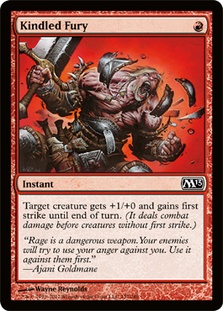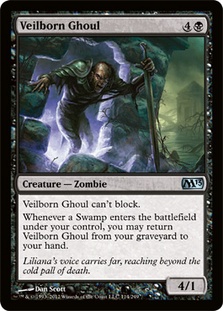Last week I wrote an article that was very well received explaining why I just never pick some cards that I don’t think are good enough to make some decks. In doing so, I also talked about taking “worse cards” over “better cards” if the worse card has higher upside in a particular deck, especially if the better card isn’t impressive in any deck. Some things I said could be interpreted as arguing for a worse card with higher variance over a better card based on the principle of maximizing potential upside. This is a viable but risky way to draft, and it’s definitely not always right.
This is intended as a rebuttal to my own article. I want to talk about another way to draft.
Before Mike Hron moved to Curacao he lived in Madison, and I drafted with him pretty often. For those who don’t know, he’s an exceptional drafter who won Pro Tour Geneva and made Top 8 of Pro Tour Kuala Lumpur back when there were still Pro Tours that were exclusively Draft.
It was hard to learn a lot from playing with him because he never really focused on discussing Magic theory; he just knew what to do. The best advice he gave on drafting (and almost the only advice he gave) was, “Draft the good cards.” Gaudenis and I often quote this at each other.
It sounds pretty obvious. Of course you’re supposed to take the good cards, but the real trick is figuring out which cards are good. In reality, that’s not what most people do.
Look at any random pick from any draft you’ve done. There’s a very good chance you didn’t take the best card in the pack.
There are a lot of factors that go into every pick you make. You have to account for your colors, the particular needs of your deck, and possible synergies with other cards. This will result in picking a card that isn’t objectively the best a huge portion of the time.
If I understand that drafting isn’t just about drafting the best cards and instead think it’s about drafting a deck, what’s the point of this advice? How can I use this overly simplistic advice that I know to be wrong?
Well, that’s where this gets interesting. It’s like deciphering the meaning of a line in a religious text. I know Hron’s an extremely successful player and an excellent drafter, so surely there is truth in his words, but how can I make sense of them when they don’t seem to fit my perceptions?
Obviously, it’s not literally true, I think, but honestly, what if it is?
It’s entirely possible that I’d do pretty well if I just took the best card out of every pack. Yes, sometimes I’d end up with a pile of cards that look like a Sealed Deck in front of me, but more often than not, I’d find myself put into a few colors because the good cards of some colors would be taken by the people in front of me, so the best card left would be of the other colors. I’d probably at least end up building a deck that was the right colors for my seat every draft, even if it was missing a few picks.
I could also start with this rule and just take it to mean, “Stay open as long as possible.” Then once I was late enough in the draft that I’d have to lock my colors to get a deck, I could start shifting my picks into specific colors to account for that.
Still, I’m not really sure his advice was just, “Stay open for the first several picks, and don’t commit to the colors of your first two picks.”
I think his advice really started to sink in for me when I watched him draft a cube for the first time. His deck just looked like a Vintage deck. It was a pile of restricted cards that were objectively the most powerful cards in Magic, and then he’d just find some way to win a game after playing several cards that gave him unfair rates on acquiring various resources. It wasn’t beatdown or ramp or combo or control, it was just degenerate cards being powerful (a more focused cube deck strives to be powerful cards being degenerate).
What would this mean in a real Draft format, like M13, and what are the implications?
When you draft weak cards with narrow applications that theoretically give them “higher upside” like Trumpet Blast or Kindled Fury over Canyon Minotaur or when you draft a sideboard card over a weak card that you might play main but probably won’t, you’re gambling a little. You’re risking a potential playable for a potential good playable. I think this is a risk worth taking most of the time, but it has costs.
The reason you can afford to make this gamble is because you’re unlikely to play either card. The reason you’re unlikely to play either card is that modern sets, particularly M13 (and particularly not AVR), have an excess of playables, such that you can afford to “waste” several picks and still only play good cards.
You get 42 picks, but you probably only play ~24 cards from those picks, so the big question is how to spend the last eighteen picks. You can spend them on defensively drafting cards you don’t want to play against, you can spend them on sideboard cards, you can spend them on speculative cards that will only make your deck if you end up playing a certain style of deck even within your colors, or you can spend them waffling between colors with good, high pick cards that you’re not playing in order to keep your options open. There are a variety of other things you can do.
If you spend your first five picks taking cards of five different colors and you know you’ll ultimately only play two colors, you’re spending three picks to stay open. Three of your eighteen picks isn’t a big deal, but the fact that they’re picks in your top five is significant since not all picks are created equal. If you assume you’re going to get around five unplayable cards per pack no matter what, that’s fifteen of your cards, and you only get three to work with. Fortunately, these days I think you only get 2-3 unplayables per pack if you’re in the right colors, and that gives you a lot more wiggle room.
If you commit early to playing all of your cards and instantly start drafting to maximize your early picks, you can spend a lot of picks on sideboard cards and cards with potential upside for your maindeck if it develops a certain way. That mostly describes how I usually draft.
If you choose to be flexible, just take the best card every pick, and you accept that this means you’re wasting a few extra early picks, you need to start being more careful to have enough playables. This means you’re going to have to hedge more. When you abandon a color that you have four cards in, you have to take a card you’re sure you can play over one you’re most likely not going to want to play, and this is where you’ll be glad that Canyon Minotaur is still in the pack for you.
I’ve seen a number of decks with overcosted vanilla creatures lately, and they’re usually decks with awesome spells. It’s clear what happened there. The person drafting was taking removal early and then had to have some creatures so took whatever was left at the end of the pack. It’s not pretty to have to win with Canyon Minotaurs, Wind Drakes, and Fire Elementals, but when you have Divinations full of Searing Spears to deal with their creatures, any body can get the job done.
This is just the inverse of the decks that are full of Flinthoof Boars and Mogg Flunkies that were probably early picks. These decks have to be rounded out with Kindled Fury and Mark of Mutiny because you didn’t take removal early and you need some way to get your guys through if they cast a four-toughness creature.
My point here is that drafting risky cards that you wouldn’t be embarrassed to play if things go a certain way is expected to cost a certain number of picks per draft. Drafting good cards without thinking about synergy, curve, or potentially even color can also be expected to cost some number of picks per draft. Either one of these costs is acceptable, but there’s a good chance that if you try to combine them you’ll spend more picks than you have and end up without enough playables.
Counting your playables as you draft is extremely important, as it tells you how much you can afford to take risky picks that are likely to have some cost.
You can come up with a plan going into a draft about how you think your picks should be spent, but it’s also important to adjust based on how the draft is going to account for how many picks you’ll have to spend.
Last night, I was watching Alex Borteh’s stream, and he had a R/B aggro deck that was going very well. He had multiple Mogg Flunkies, so he clearly wanted more cheap creatures that would enable them to attack. There was a Walking Corpse in the pack that could get the job done; it would be a cheap creature in his aggressive deck that wanted one, it wouldn’t be impressive, but it could fill the curve. In the same pack, there was a Veilborn Ghoul. Veilborn Ghoul didn’t look like a great card in his deck, but I periodically draft decks that I just know can’t beat a Veilborn Ghoul.
The fact that has been the case with multiple decks I’ve drafted leads me to believe that Veilborn Ghoul is a reasonable sideboard card, since any deck would want it against the decks that can’t beat it. I said he should take the Veilborn Ghoul even though it was worse in his deck because the draft was going well and there was no way he would have to play a Walking Corpse. In the end, he didn’t play the Walking Corpse, and he had enough two-drops that he would never side it in. Therefore, his deck would have been marginally better with the extra sideboard card.
Making that kind of pick requires awareness of how the draft is going and how many playables you have and confidence that you don’t need to hedge, but if you can make that pick every time it’s correct your decks will be better on average. If you always “take the good cards,” the fact that you’ll waste early picks on off-color cards means that you won’t be in that position as often. On the other hand, if you weren’t aware enough to take advantage of being in that position in the first place, then there really isn’t a cost. When you draft too safe, you’re giving up marginal value somewhere, but there are arguments for taking risks at many different spots in a draft.
The basic point of synthesis between this article and my previous one is that you shouldn’t “draft scared.” Don’t draft conservatively, but you also have to pick your spots wisely and know when you have wiggle room and when you don’t. Late solid playables can bail you out if you take some time to get your footing, though. So remember that if it’s halfway through the first pack and you find yourself passing a late Sentinel Spider, you should probably reevaluate your color selection and have a willingness to move because those Spiked Baloths will always be there to fill out your deck if green is open and you didn’t see it right away.
Thanks for reading,
Sam
@samuelhblack on Twitter


